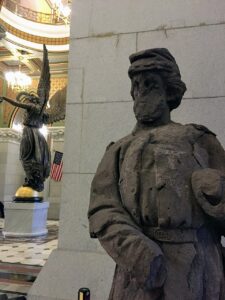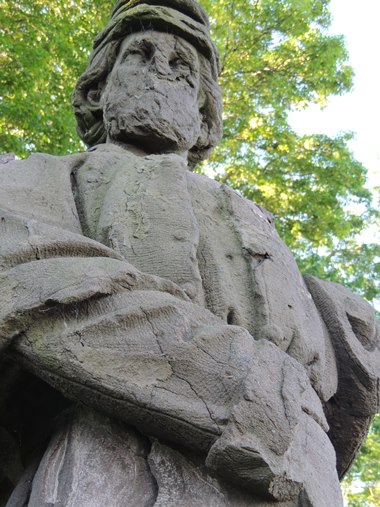Last Updated: July 2, 2025
By Anthony Roy
The Forlorn Soldier is a brownstone statue created by James G. Batterson. For over a century, the story of the statue was that people rejected it because the right foot was mistakenly thrust forward, which is opposite of the traditional parade-rest military pose. This statue faced years of environmental degradation, causing it to lose its hands, rifle, bayonet, and part of its face.
Conservation efforts resulted in moving the statue to the Connecticut State Capitol building and demystifying the soldier’s past. We now know that the statue was a prototype of an important statue model that Batterson reproduced several times to commemorate the Civil War generation. Today, experts continue to preserve both the statue and its history for future generations.
Crafting the Forlorn Soldier

James Batterson from the Commemorative Biographical Record of Hartford County, Connecticut, Vol. 1, 1901. – Internet Archive. Used through Public Domain.
The contractor of the statue was Batterson’s Monumental Works, a company owned by political heavyweight and founder of Traveler’s Insurance Company, James G. Batterson. Charles Conrads, a German immigrant and Civil War veteran, was the lead artisan entrusted to hew the rough brownstone into a tribute to sacrifice and unity. This purposefully imperfect sculpture was produced as a prototype. It was the first standing Civil War figure modeled by Charles Conrads and certainly the first such monument in the state of Connecticut.
Conrads crafted the old brownstone soldier, known as the Forlorn Soldier, as a prototype for a series of identical Civil War soldier statues produced by Batterson’s monument company. The fact that Conrads crafted this soldier from brownstone is significant. The Forlorn Soldier is the earliest of three Civil War soldier figures that Conrads crafted from the sedimentary rock. Granite, a much more durable igneous stone, was the preferred material used in virtually all of Batterson’s other statues. The material for the old brownstone soldier was quarried in Portland, Connecticut, shipped on the Connecticut River, and transported to Batterson’s shop at 650 Main Street in Hartford. Batterson entrusted Conrads to shape the porous block. The sculptor followed a calculated and precise process because the cost of error was very high.
For many decades, the oral history of the old brownstone soldier claimed that people rejected the statue because the wrong foot, the right foot, was forward. It is nearly impossible, however, to imagine that Charles Conrads, an experienced soldier and accredited sculptor, made such a mistake. Surely, Conrads received instruction on the appropriate footing as prescribed in the military drill manual. It is also important to remember that Conrads was a highly capable artist entrusted with all of Batterson’s most important sculptures. While the footing of the soldier intentionally helped balance the statue, unfortunately, the design proved flawed. The statue was too top heavy and thus unfit for commercial reproduction. Later models included a tree stump to add further support and weight at the bottom of the statue.
Batterson’s stone shop commonly kept the pieces they did not sell. An 1877 Hartford Courant article explained, “facsimiles of past productions are preserved in plaster, clay and photograph.” It is no wonder that the brownstone soldier remained on the Batterson property until Michael and John Kelly rediscovered it in the 1890s. The Kelly brothers resurrected the old brownstone soldier, provided the statue with a pedestal, and showcased the figure on Charter Oak Avenue. It was during the soldier’s sojourn at this site that the brownstone statue befell brutal treatment and developed into a legend. In 1932, the Hartford Courant reported that parts of its face, hands, and musket were already gone and the reporter recorded the “wrong foot forward” myth that ultimately dominated the narrative of the old brownstone soldier for 80 years.
Conserving the Forlorn Soldier

The Forlorn Soldier in the Connecticut State Capitol Building in Hartford, circa 2018. – By Laura A. Macaluso, Wikimedia Commons. Used through a CC BY-SA 4.0 license.
Although there were many people who admired this Civil War relic, there were many times in its history when people felt that the statue’s time was up and it needed to be discarded. In the midst of Connecticut’s sesquicentennial commemoration of the Civil War, however, interest in this soldier was reignited. The Connecticut Civil War Commemoration Commission set out to preserve the sculpture and its history.
Officials stationed the statue of the Forlorn Soldier on Airport Road in Hartford’s South End for over 45 years—having moved it from Charter Oak Avenue in the spring of 1968. There it stood amidst an industrial, urban backdrop. On July 19, 2013, the Connecticut Civil War Commemoration Commission held a ceremony to honor another relocation of the statue.
Before being lifted onto a truck, a color guard of Civil War reenactors honored the Forlorn Soldier. Peter G. Kelly and several of his family members attended and Tom Callinan, Connecticut’s former state troubadour, performed an original song dedicated to the Forlorn Soldier. The Mariano Brothers Specialty Movers used a crane to set the statue onto a truck bed. From that location, they transported the Forlorn Soldier to ConservArt in Hamden, Connecticut. Francis Miller, the proprietor of ConservArt, worked over the next two months to stabilize the statue and repair previous restoration attempts before its final move to the Connecticut State Capitol.
On September 18, 2013, 150 years after the battle of Antietam, hundreds of Nutmeggers gathered at the Connecticut State Capitol to pay their respects to the Forlorn Soldier. Just days before, the soldier was placed in his permanent home within the building that James Batterson constructed as a shrine to the Civil War generation. The Forlorn Soldier, now protected from the elements, joined other relics commemorating the Civil War. Donald E. Williams Jr., senate president pro tempore, Linda Schwartz, commissioner of the Connecticut Department of Veterans Affairs, Peter G. Kelly, proprietor of the statue, and political and constitutional historian Matthew Warshauer, all spoke at the ceremony.
Anthony Roy is a regional historian and social studies teacher at Connecticut River Academy whose work related to the Forlorn Soldier was completed as a part of his candidacy for a master’s in public history from Central Connecticut State University and as a part of the Connecticut Civil War Commemoration Commission’s efforts to study and inspire awareness of the American Civil War and Connecticut’s involvement in it.
This article has been updated, learn more about content updating on ConnecticutHistory.org here.









